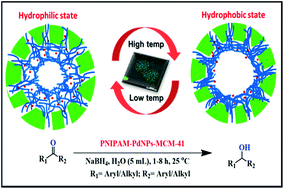In situ thermosensitive hybrid mesoporous silica: preparation and the catalytic activities for carbonyl compound reduction†
Abstract
In this study, free-radical polymerisation inside MCM-41 mesopores was examined to expose a construction route for a temperature-responsive switchable polymer–silica nanohybrid material with well-defined porosity. Herein, we introduced a vinyl monomer (N-isopropyl acrylamide), a cross-linker, and an AIBN initiator into the palladium nanoparticle incorporated MCM-41 pore channels using the wet-impregnation method followed by in situ radical polymerisation. The structural properties of the synthesised PNIPAM–PdNP–MCM-41 catalyst were analysed by various sophisticated analytical techniques. The temperature switchable nanohybrid catalyst was used to reduce carbonyl compounds to their corresponding alcohols. The catalyst showed high catalytic efficiency and robustness in an aqueous medium at 25 °C. Moreover, the system's polymer layer remarkably boosted catalytic selectivity and activity for carbonyl compound reduction as compared to other controlled catalysts. The suggested switchable system can be employed as a temperature-controllable heterogeneous catalyst and highlights a substitute technique to counter the methodical insufficiency in switchable supported molecular catalytic system production.



 Please wait while we load your content...
Please wait while we load your content...